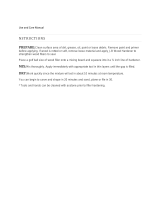
CONTENTS
GENERAL INFORMATION
GENERAL GUIDE LINES AND PRECAUTIONS .....................................................................................GI-2
SRS AIR-BAG ........................................................................................................................................GI-3
ELECTRONIC PARTS ...........................................................................................................................GI-4
CORROSION PROTECTION AND SEALING ..........................................................................................GI-4
SIDE BODY PANELS.............................................................................................................................GI-4
WELDING ..............................................................................................................................................GI-5
BODY CONSTRUCTION
FRONT & REAR BODY .........................................................................................................................BC-2
SIDE BODY ..........................................................................................................................................BC-3
BODY DIMENSIONS
GENERAL.............................................................................................................................................BD-2
MEASUREMENT METHOD ..................................................................................................................BD-2
FRONT BODY .......................................................................................................................................BD-4
SIDE BODY ..........................................................................................................................................BD-6
INTERIOR A..........................................................................................................................................BD-8
INTERIOR B........................................................................................................................................BD-11
REAR BODY .......................................................................................................................................BD-13
UNDER BODY (PROJECTED DIMENSIONS) .....................................................................................BD-15
UNDER BODY (ACTUAL-MEASUREMENT DIMESIONS) ................................................................... BD-18
BODY PANEL REPAIR PROCEDURE
FENDER APRON PANEL ASSEMBLY................................................................................................BP-2
FRONT SIDE MEMBER(PARTIAL)........................................................................................................BP-7
FRONT PILLAR...................................................................................................................................BP-11
SIDE SILL (PARTIAL)..........................................................................................................................BP-19
CENTER PILLAR ................................................................................................................................ BP-22
QUARTER PANEL .............................................................................................................................. BP-31
BACK COMPLETE PANEL ASSEMBLY AND REAR FLOOR SIDE MEMBER .....................................BP-36
BODY SEALING LOCATION
FLOOR..................................................................................................................................................BS-2
UPPER AND SIDE BODY .....................................................................................................................BS-5
UNDER BODY.......................................................................................................................................BS-8
HOOD ...................................................................................................................................................BS-9
TRUNK LID .........................................................................................................................................BS-10
CORROSION PROTECTION
ZINC-PHOSPHATE COAT & CATIONIC ELECTRODEPOSITION PRIMER ...........................................CP-2
ANTIVIBRATION PADS-LOCATION & SECTION ..................................................................................CP-3
ATTACHMENT OF ANTIVIBRATION PADS ..........................................................................................CP-6
UNDER BODY COAT ...........................................................................................................................CP-7
SIDE BODY ..........................................................................................................................................CP-8
CAVITY WAX INJECTION.....................................................................................................................CP-9
UNDER BODY ANTI-CORROSION AGENT .........................................................................................CP-10
GI
BC
BD
BP
BS
CP
BT
PP
























